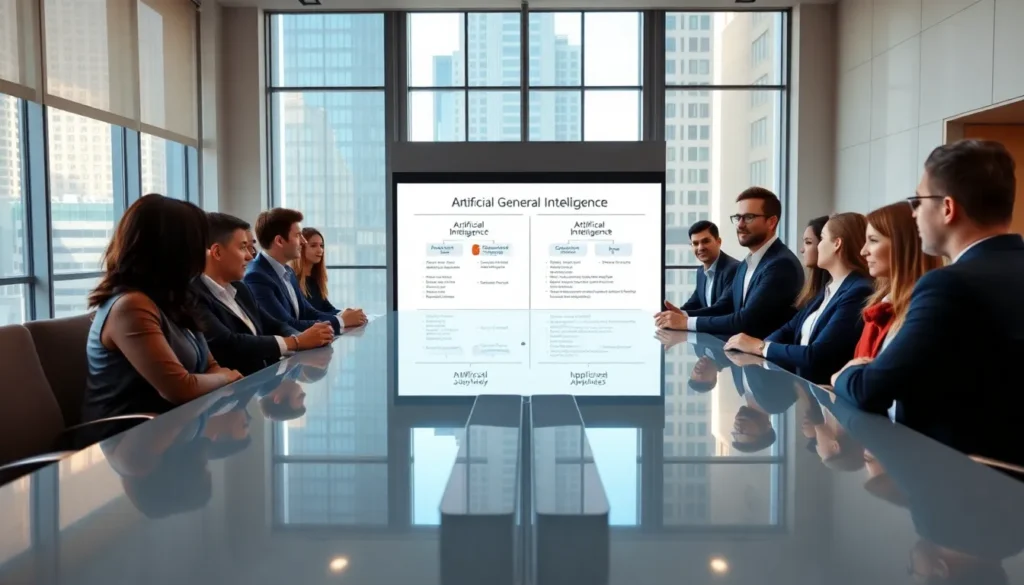Table of Contents
TogglePicture this: your team is suddenly thrown into a chaotic cyber crisis, and everyone is scrambling like caffeinated squirrels. Without a solid plan, chaos reigns. Enter the tabletop exercise. Funny name, serious business. This exercise not only strengthens your cybersecurity posture but also ensures that your organization is ready to handle the unexpected, without the caffeine jitters. Buckle up as we investigate into the world of tabletop exercises in cybersecurity, guiding your organization to be one step ahead of the cybercriminals.
Understanding Tabletop Exercises in Cybersecurity

Tabletop exercises serve as a simulated environment where teams can practice their response to a cybersecurity incident without any real-world consequences. Think of it like a rehearsal before the big show. But, unlike ordinary rehearsals, these exercises are crucial for identifying gaps in an organization’s cybersecurity plan. During these discussions, teams can uncover vulnerabilities and enhance their readiness without facing the pressure of an actual crisis. Importantly, tabletop exercises encourage collaboration across departments, ensuring that everyone is on the same page. They allow organizations to create a realistic scenario tailored to their specific needs, making it a valuable tool in the cybersecurity toolkit.
The Importance of Tabletop Exercises for Organizations
The significance of tabletop exercises can’t be overstated. For one, they help organizations develop a response strategy that works. When teams simulate scenarios, they can practice communication protocols, determine resource allocation, and more. This proactive approach enables businesses to avoid being caught off-guard. Also, tabletop exercises stimulate an environment of teamwork and foster a culture of trust within an organization. When employees feel confident in their skills and their team’s ability to respond, the entire organization’s resilience against attacks sees a boost. Plus, regular testing and review keep an organization’s cybersecurity policies current, ensuring that they evolve with emerging threats.
Key Components of an Effective Tabletop Exercise
An effective tabletop exercise consists of several key components that must work together seamlessly to achieve the desired outcomes.
Designing a Cybersecurity Tabletop Exercise
Designing a cybersecurity tabletop exercise begins with identifying the organization’s objectives. What specific outcomes does the organization want from the exercise? Next comes the planning phase, where teams brainstorm potential scenarios that could realistically occur in their environment. It’s crucial to tailor the scenarios to the industry, size, and specific needs to ensure relevance. Also, including a mix of technical and non-technical elements helps keep the exercises dynamic and engaging.
Choosing Scenarios and Objectives
Choosing the right scenarios is pivotal. It could be a ransomware attack, a data leak, or even a phishing attempt. Each scenario should challenge the team’s decision-making and response processes. By having clearly defined objectives, such as improving incident response time or enhancing communication, participants remain focused on what truly matters during the exercise.
Assembling the Right Team
Assembling the right team is also critical. This should involve representatives from various departments, including IT, HR, legal, and public relations. The more diverse the team, the more comprehensive the exercise will be. It’s essential that each member understands their role if a real incident.
Facilitating the Exercise Effectively
Facilitating the exercise effectively depends on how well the facilitator can guide discussions while keeping the atmosphere engaging. The facilitator should set clear ground rules, such as encouraging open dialogue and fostering an inclusive environment. Also, it’s important to keep the discussions on track, ensuring participants remain focused on the scenario at hand. Presenting realistic challenges and injecting unexpected twists can keep the exercise lively while encouraging creative problem-solving. Also, timely feedback during the exercise gives participants insights into their decision-making processes.
Evaluating the Results of the Exercise
Once the exercise is complete, evaluating the results is paramount. This post-exercise analysis helps organizations pinpoint what went well and where improvements are needed. Collecting feedback from participants can provide invaluable insights. It’s also beneficial to document any decisions made and action points identified during the exercise for future reference. Establishing a follow-up process to carry out changes derived from the exercise ensures that lessons learned are consistently integrated into the organization’s cybersecurity strategy.
Best Practices for Conducting Tabletop Exercises
To maximize the effectiveness of tabletop exercises, organizations should follow a few best practices. First, schedule them regularly, quarterly or biannually works well for many. Keeping the exercises fresh is key to ensuring ongoing engagement. Second, make sure to involve senior leadership: their input and support can elevate the exercise’s importance. Third, consider varying the scenarios each time to cover different aspects of cybersecurity. Be prepared for the unexpected: real-life incidents rarely go according to plan. Finally, retain a focus on continual improvement, recognizing that each exercise offers a learning opportunity.






